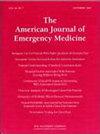侵入性血压监测不能提高脓毒症危重患者的生存率
IF 2.7
3区 医学
Q1 EMERGENCY MEDICINE
引用次数: 0
摘要
背景:动脉导管侵入性血压监测是感染性休克治疗的常用手段,但其对患者恢复的影响尚不清楚。我们的目的是确定有创性血压监测是否能提高生存率、影响住院时间(LOS)或加速休克消退。方法对2021年1月至2023年12月ICU感染性休克患者进行多中心病例对照研究。有创血压监测患者行动脉插管;对照组没有。患者根据确切的顺序器官衰竭评估(SOFA)评分、机械通气状态和倾向评分按年龄、种族和性别进行1:1匹配。主要结局是全因住院病人死亡率和ICU LOS。结果在739例符合条件的患者中,匹配326例。平均年龄67±14岁,男性占57%。病例和对照组的住院死亡率相似(41%对38%,p = 0.43)。动脉线患者ICU LOS较长(中位数5.6 vs 3.7天,p <;0.01)。降血压药物停药时间(28.6 h vs. 26.5 h, p = 0.82)无显著差异。有动脉线的患者每日抽血较多(中位数为9比7,p = 0.046),最低血红蛋白水平较低(中位数为7.0比7.8 g/dL, p <;0.01),并且接受了更多的红细胞输注(中位数2.2比1.5单位,p = 0.03)。结论有创动脉导管血压监测不能提高危重感染性休克患者的生存率。它与住院时间延长、血液采样增加和输血需求增加有关。这些发现提示有必要重新评估在这一人群中动脉导管的常规使用。本文章由计算机程序翻译,如有差异,请以英文原文为准。
Invasive blood pressure monitoring does not improve survival in septic critically ill patients
Background
Invasive blood pressure (BP) monitoring with arterial catheters is commonly used in the management of septic shock, however its impact on recovery remains unclear. We aimed to determine whether invasive BP monitoring improves survival, impacts length of stay (LOS) or accelerates shock resolution.
Methods
We conducted a multicenter case-control study of ICU patients with septic shock from January 2021 to December 2023. Cases received arterial lines for invasive BP monitoring; controls did not. Patients were matched 1: 1 based on exact Sequential Organ Failure Assessment (SOFA) score, mechanical ventilation status, and propensity scores using age, race, and sex. Primary outcomes were all-cause inpatient mortality and ICU LOS.
Results
Among 739 eligible patients, 326 were matched. The mean age was 67 ± 14 years, and 57 % were male. Inpatient mortality was similar between cases and controls (41 % vs. 38 %, p = 0.43). Patients with arterial lines had longer ICU LOS (median 5.6 vs. 3.7 days, p < 0.01). Time to vasopressor discontinuation (28.6 vs. 26.5 h, p = 0.82) did not differ significantly. Patients with arterial lines had more daily blood draws (median 9 vs. 7, p = 0.046), lower nadir hemoglobin levels (median 7.0 vs. 7.8 g/dL, p < 0.01), and received more red blood cell transfusions (median 2.2 vs. 1.5 units, p = 0.03).
Conclusion
Invasive BP monitoring with arterial catheters did not improve survival in critically ill patients with septic shock. It was associated with longer lengths of stay, increased blood sampling, and higher transfusion requirements. These findings suggest the need to reassess the routine use of arterial lines in this population.
求助全文
通过发布文献求助,成功后即可免费获取论文全文。
去求助
来源期刊
CiteScore
6.00
自引率
5.60%
发文量
730
审稿时长
42 days
期刊介绍:
A distinctive blend of practicality and scholarliness makes the American Journal of Emergency Medicine a key source for information on emergency medical care. Covering all activities concerned with emergency medicine, it is the journal to turn to for information to help increase the ability to understand, recognize and treat emergency conditions. Issues contain clinical articles, case reports, review articles, editorials, international notes, book reviews and more.

 求助内容:
求助内容: 应助结果提醒方式:
应助结果提醒方式:


